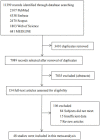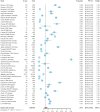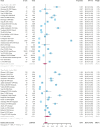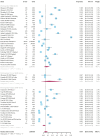Global prevalence and epidemiological trends of Hashimoto's thyroiditis in adults: A systematic review and meta-analysis
- PMID: 36311599
- PMCID: PMC9608544
- DOI: 10.3389/fpubh.2022.1020709
Global prevalence and epidemiological trends of Hashimoto's thyroiditis in adults: A systematic review and meta-analysis
Abstract
Objective: Although Hashimoto's thyroiditis is associated with cardiovascular disease and malignancy, the global status of Hashimoto's thyroiditis is not well characterized across regions. Our objective was to evaluate the prevalence and trends of Hashimoto's thyroiditis in adults in regions with different economic income levels around the world.
Methods: For this systematic review and meta-analysis, we searched PubMed, Embase, MEDLINE, Scopus, and Web of Science databases, and 48 random-effects representative studies from the inception to June 2022 were included without language restrictions to obtain the overall prevalence of Hashimoto's thyroiditis in adults worldwide. In addition, we stratified by time of publication, geographic region, economic level of the region of residence, gender, diagnostic method, etc.
Results: A total of 11,399 studies were retrieved, of which 48 met the research criteria: 20 from Europe, 16 from Asia, five from South America, three from North America, and three from Africa. Furthermore, there are two projects involving 19 countries and 22,680,155 participants. The prevalence of Hashimoto's thyroiditis was 7.5 (95%CI 5.7-9.6%), while in the low-middle-income group the prevalence was 11.4 (95%CI 2.5-25.2%). Similarly, the prevalence was 5.6 (95%Cl 3.9-7.4%) in the upper-middle-income group, and in the high-income group, the prevalence was 8.4 (95%Cl 5.6-11.8). The prevalence of Hashimoto's varied by geographic region: Africa (14.2 [95% CI 2.5-32.9%]), Oceania (11.0% [95% CI 7.8-14.7%]), South America and Europe 8.0, 7.8% (95% Cl 0.0-29.5%) in North America, and 5.8 (95% Cl 2.8-9.9%) in Asia. Although our investigator heterogeneity was high (I2), our results using a sensitivity analysis showed robustness and reliability of the findings. People living in low-middle-income areas are more likely to develop Hashimoto's thyroiditis, while the group in high-income areas are more likely to develop Hashimoto's thyroiditis than people in upper-middle-income areas, and women's risk is about four times higher than men's.
Conclusions: Global Hashimoto's thyroiditis patients are about four times as many as males, and there are discrepancies in the regions with different economic levels. In low-middle-income areas with a higher prevalence of Hashimoto's thyroiditis, especially countries in Africa, therefore local health departments should take strategic measures to prevent, detect, and treat Hashimoto's thyroiditis. At the same time, the hidden medical burden other diseases caused by Hashimoto's thyroiditis should also be done well.
Systematic review registration: https://www.crd.york.ac.uk/prospero/, identifier: CRD 42022339839.
Keywords: Hashimoto's thyroiditis; epidemiological trends; global prevalence; meta-analysis; systematic review.
Copyright © 2022 Hu, Chen, Shen, Tian, Sheng and Que.
Conflict of interest statement
The authors declare that the research was conducted in the absence of any commercial or financial relationships that could be construed as a potential conflict of interest.
Figures













References
-
- Lerner A, Jeremias P, Matthias T. The world incidence and prevalence of autoimmune diseases is increasing. Int J Celiac Dis. (2015) 3:151–5. 10.12691/ijcd-3-4-8 - DOI
Publication types
MeSH terms
LinkOut - more resources
Full Text Sources
Miscellaneous

